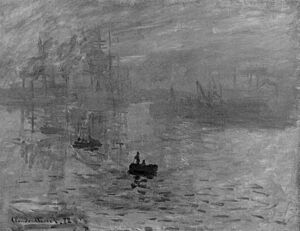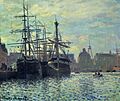Impression, Sunrise facts for kids
Quick facts for kids Impression, Sunrise |
|
|---|---|
| French: Impression, soleil levant | |
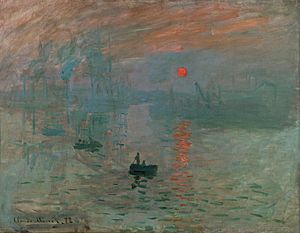 |
|
| Artist | Claude Monet |
| Year | 1872 |
| Medium | Oil on canvas |
| Movement | Impressionism |
| Dimensions | 48 cm × 63 cm (18.9 in × 24.8 in) |
| Location | Musée d'Orsay, Paris |
Impression, Sunrise (in French: Impression, soleil levant) is a famous painting from 1872 by Claude Monet. It was first shown in Paris in April 1874 at an art show that later became known as the "Exhibition of the Impressionists". This painting is often said to have given the Impressionist art movement its name.
Impression, Sunrise shows the port of Le Havre, which was Monet's hometown. Usually, you can see it at the Musée Marmottan Monet in Paris. However, it sometimes travels to other museums for special exhibitions.
Contents
History of the Painting
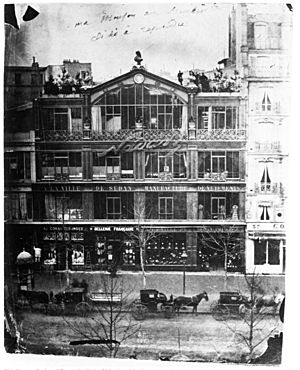
In 1872, Monet visited his hometown of Le Havre in France. While there, he painted several artworks showing the port. He created six paintings of the port at different times of day: dawn, day, dusk, and night. He also painted them from various spots, sometimes from the water and sometimes from a hotel room looking down.
Impression, Sunrise became the most well-known painting from this series. It was first shown in April 1874 in Paris. This exhibition was put on by a group of artists including Monet, Edgar Degas, Camille Pissarro, Pierre-Auguste Renoir, and Alfred Sisley. They showed over 200 artworks to about 4,000 people. Some art critics at the time were not very kind about the new style.
Sadly, in 1985, the painting was stolen from the Musée Marmottan Monet. But good news! It was found and returned to the museum in 1990. It went back on display for everyone to see in 1991.
How "Impression" Led to Impressionism
Monet said he named the painting Impression, Sunrise because of its hazy, less detailed style. He explained, "They asked me for a title for the catalogue. It couldn't really be taken for a view of Le Havre, and I said: 'Put Impression.'" Some art experts believe Monet might have used "Impression" to suggest his painting wasn't meant to be perfectly finished. However, critics still said it looked unfinished.
The word "impressionism" wasn't completely new. It had been used before to describe the feeling or effect of paintings, especially from the Barbizon School. Artists like Daubigny and Manet had used the term for their own works.
A famous art critic named Louis Leroy wrote about the 1874 exhibition in a newspaper called Le Charivari. He used the word "Impressionism" to describe the new art style he saw. He said Monet's painting, Impression, Sunrise, was a perfect example of this new style.
Before the 1860s, "impression" described how a natural scene affected a painter, or how a painting affected someone looking at it. Later, it started to describe paintings that showed this kind of effect. Eventually, "Impressionism" became the name for the entire art movement. Even though the term was first used to make fun of the style, artists and the public quickly adopted it. Monet's Impression, Sunrise is seen as the painting that truly started the Impressionist movement and gave it its famous name.
Monet's Painting Style
The hazy look of Impression, Sunrise was different from traditional landscape paintings. Those paintings usually aimed for perfect, idealized beauty. Monet's loose brush strokes suggest the scene rather than showing every tiny detail. This was a key part of the new Impressionist movement. During a time when France was becoming more industrial, this style showed a new way for artists to express themselves.
Colors in the Painting
Monet made a group of paintings from his hotel room using a gray base layer. This layering creates a feeling of depth, even without precise details. It makes the scene feel real and alive, like Le Havre, but not an exact copy. In Impression, Sunrise, the sky and water blend together. The edges between objects are not clear. The colors mix, creating a misty, glowing feeling. The touches of blue-gray and orange seem to appear through the fog, reflecting on the water.
How Bright is the Sun?
You might think the sun in the painting is the brightest part. But if you measure it with a special tool, you'd find it's actually the same brightness (or luminance) as the sky around it! Margaret Livingstone, a professor who studies the brain at Harvard University, explained this. She said, "If you make a black and white copy of Impression: Sunrise, the Sun disappears [almost] entirely."
Livingstone said this makes the painting feel very real. This is because the older part of our brain that sees things (which most mammals have) only notices brightness, not color. So, to that part of the brain, the sun in the painting would be invisible. Only the newer part of our visual cortex (found in humans and other primates) sees color. Other scientists have found that these brightness qualities can make the sun seem to fade from view if you stare at it.
Monet's Later "Impressions"
In an interview, Monet talked about how he painted landscapes like the port of Le Havre. He said, "A landscape is only an impression, instantaneous, hence the label they've given us-- all because of me, for that matter. I'd submitted something done out of my window at Le Havre, sunlight in the mist with a few masts in the foreground jutting up from the ships below. They wanted a title for the catalog; it couldn't really pass as a view of Le Havre, so I answered: 'Put Impression'. Out of that they got impressionism, and the jokes proliferated...."
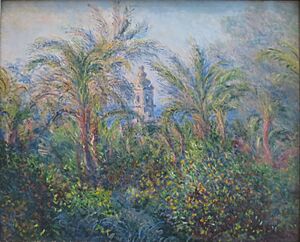
After 1874, as the Impressionist movement grew, Monet continued to name other paintings with similar titles. These titles, like Effet de brouillard, impression (1879) or Garden at Bordighera, Impression of Morning (1884), connected them to Impression, Sunrise in style and influence. These later works were also often hazy or misty, showing Monet's skill at capturing quick, fleeting moments in nature.
Even though the movement and the painting were first met with some arguments, Monet's Impression, Sunrise helped give the Impressionist movement its name and fame. Many believe it perfectly shows what Impressionism is all about in its style, subject, and lasting impact.
Monet's Paintings of the Port of Le Havre
See also
- List of paintings by Claude Monet
- Rayleigh scattering




